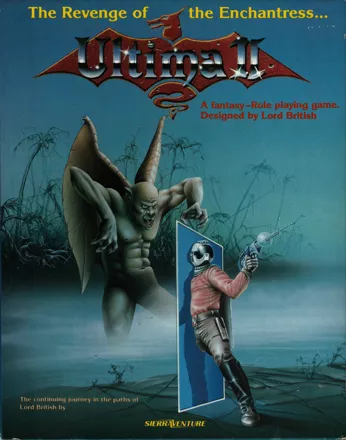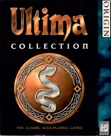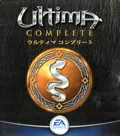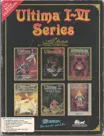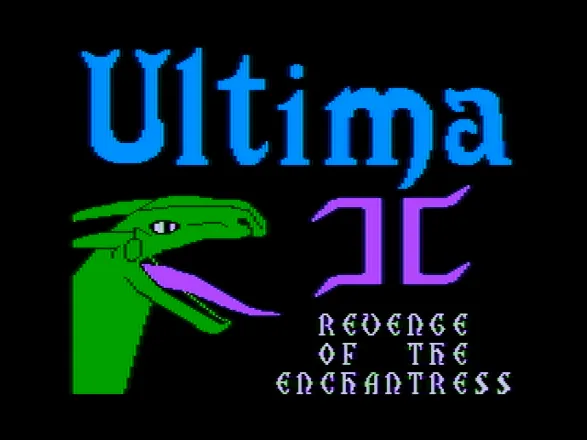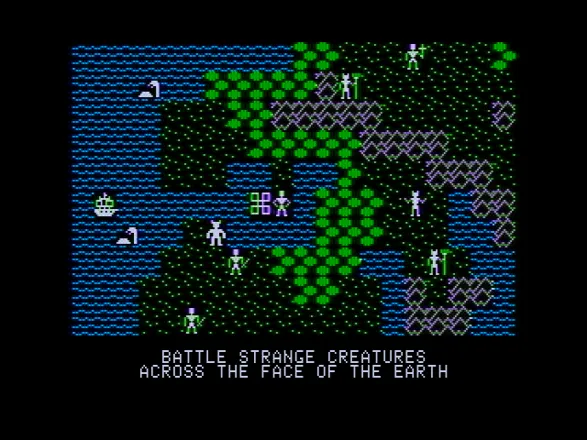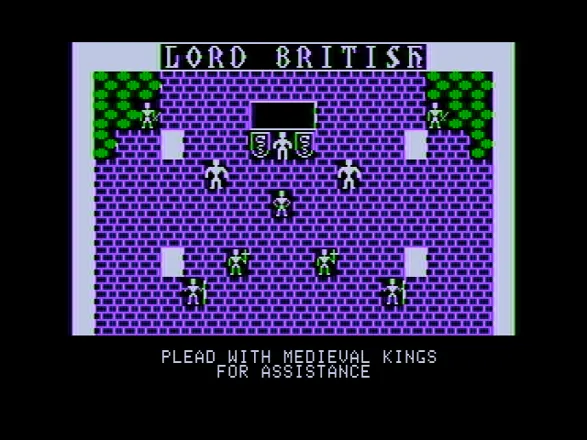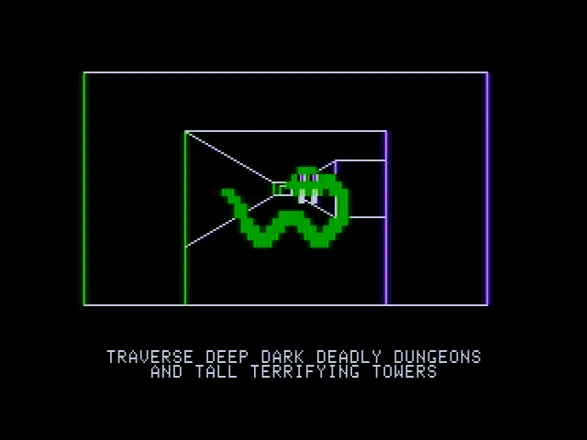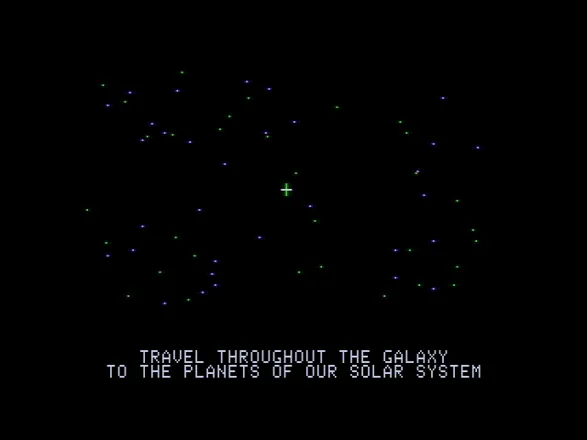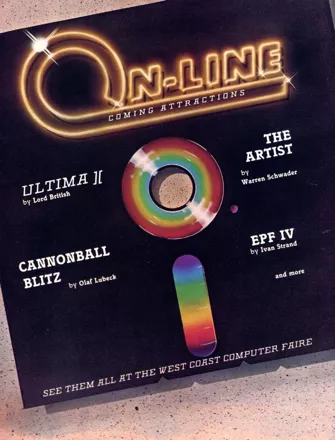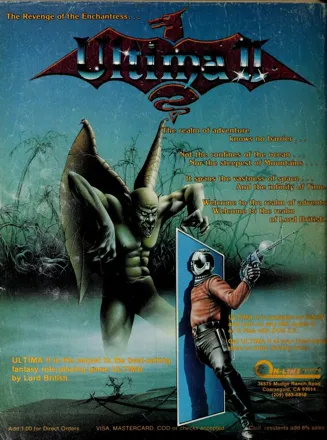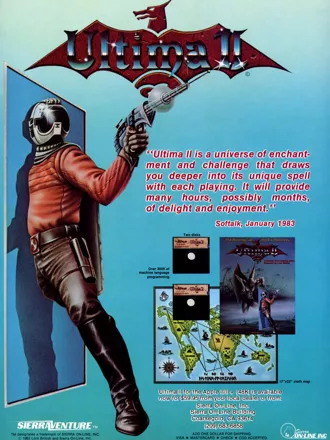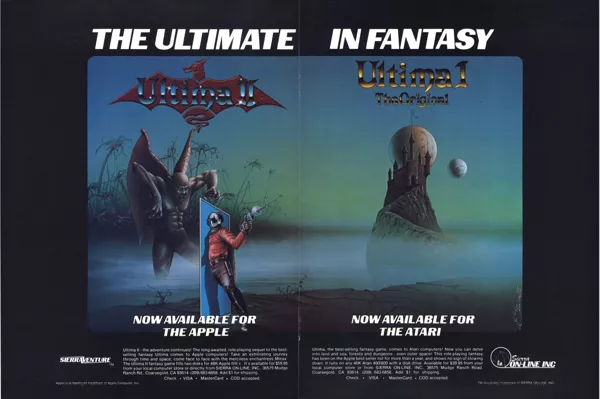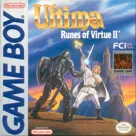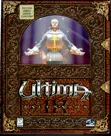Ultima II: The Revenge of the Enchantress...
Description official descriptions
The sequel to Ultima featured several improvements over the original, such as larger town maps, and the concept of traveling through time gates into different eras on Earth. Other than that the gameplay is pretty much the same as in Ultima I, with your single character roaming the land fighting monsters and looking for key items.
In the original Ultima a hero from a certain third rate blue planet orbiting an insignificant yellow sun came to the world of Sosaria and slew the evil wizard Mondain before he could fulfill his dreams of universal domination. Thus peace was brought to Sosaria, and the hero hailed as a champion of the people of all time.
Unfortunately, Mondain happened to have a young apprentice/lover named Minax who is understandably upset over his death. Using her considerable powers, Minax travels through time and space to the hero's homeworld of Earth and instigates a nuclear war, thus serving the dual purpose of working out her frustration as well as erasing the hero from history. Of course, as the hero, this works out rather badly for you, and so with the help of Lord British you must travel through time and somehow find Minax and prevent the events which culminate in the destruction of Earth.
Spellings
- ウルティマ2 女魔法使いの復讐 - Japanese spelling
Groups +
Screenshots
Promos
Credits (Apple II version)
13 People (12 developers, 1 thanks)
| Programming | |
| Game Design | |
| Inspiration | |
| Special thanks to |
|
Reviews
Critics
Average score: 74% (based on 5 ratings)
Players
Average score: 3.9 out of 5 (based on 113 ratings with 7 reviews)
Has trouble keeping the player motivated
The Good
After Ultima became a big success for Richard Garriott, the logical thing to try was creating a sequel in which everything was bigger, better, and cooler. Ultima II achieved that. The improvements are many, and not just minor ones, too.
The game world is a couple of times the size of the original Ultima. You don't only travel through different kingdoms anymore, you also travel through time. Not only do you once more venture into outer space, but now you can even land on other planets of our solar system, and explore them. Towns are now themselves multi-screen environments, each with a unique structure. And there many other peaceful inhabitants wandering around, although they don't have much to say yet. Along with dungeons, there are also towers, and both of them have over a dozen uniquely designed levels each, with improved monster graphics.
The list goes on. The scope of the game is absolutely amazing, even more so when comparing it to that of other titles of the time.
The Bad
The game's biggest problem is ultimately (pun intended) that it forgets about the players. While providing a great world to toy around in, it fails at giving players a lasting incentive to do so. This is not the fault of the story, which is basically a clone of the first Ultima - getting strong enough to battle an evil wizard. The whole journey to get there is just not gripping enough.
For a large part, this is due to obvious balancing issues. In the beginning, players have a hard time keeping their injuries and travels at a minimum, in order to not run out of food or hit points early on. A while later, difficulty gives way to dullness. The remaining part of the game now mostly consists of cruising around in a battleship and firing at enemies, over and over again. That in itself wouldn't have to be completely bad, Diablo for example was just as repetitive. What made Diablo entertaining, however, was that it always kept patting the players head. An interesting item after every dozen of enemies, increasing amounts of gold, and a change in scenery every few levels.
Ultima II does have nothing of the sort. The amounts of gold and experience the player gets from fights is increasing extremely slow, and there is a general lack of enemies. This means literally hours of cruising around the world with the hero, killing hundreds and hundreds of the same types of enemies. All for a slow progression in experience levels, and a small stack of gold to increase hit points and equipment to finally be ready for the endgame. It is no rewarding experience by any standard. At most times, Ultima II more resembles work than play. To make matters worse, increasing stats can only be done through bribing a hotel clerk, which then might increase a character value, and if he does, a randomly chosen one.
But what about all the nice features I mentioned? They don't really matter. The dungeons are nice, but there is no reason to visit them, as the enemies are much stronger than those on the surface, yet the rewards are just as puny. And in contrast to the first Ultima, there are no quests, so why care about the other inhabitants of the world?
The Bottom Line
The only reason why I played and completed Ultima II was because of my determination to finish every Ultima game in existence. If you don't feel that urge, there's no real reason to force yourself to finish it. And believe me, you will reach a point where you would have to force yourself. Apart from the background texts in the manual, you're not missing out on a great, surprising story.
It is an interesting fact that for later releases of the DOS version in compilations, files from all the game's disks were copied to one folder, overwriting several files with identical file names. This eventually got rid of all the outer-space game maps, rendering space travel useless and the game unwinnable without applying a fan patch. The real problem is however that the game itself is so demotivating that most players probably never even got far enough to notice.
It is fun to walk around in Ultima II for a while, experience the new features it has over the first part in the series, explore the worlds and time travelling. But it is not fun enough to work towards completing the game's objectives. In the end, you will find that all the game's interesting features and elements are pointless, while the necessary ones are boring. This is a fatal combination for a game, especially after its novelty has worn off.
DOS · by Daniel Saner (3517) · 2008
More like Time Bandit fanfiction than Ultima
The Good
This game is… interesting, to say the least. The whole concept behind it is unique to this very day, and given this game came out in 1982, that’s saying a lot. Time travel combined with a villainess unleashing a horde of mythical monsters on the real world and throwing all the timelines of the world out of whack sounds like it has a lot of potential, and if this game were remade today it would probably kick ass.
On top of that, you’re not just restricted to our world, but can visit every single planet in our solar system, including the ex-planet Pluto and the mysterious planet X. Like I said, the concept behind this game is very imaginative, but that’s all that’s really good about it.
The Bad
The bad… Ok, this going to be a two parter, the first part being the first time I actually played and completed it, and the second time after I saw the movie that inspired it and the whole moongate concept: Time Bandits.
The game is very large, but also very confusing. There’s very little in terms of direction for the player, when I first played it way back in the day (back in 1998 when I first got the Ultima Collection CD), I had not the faintest idea what to do. Even after reading the manual (which was very, very well written and definitely thought provoking) I still found it very hard to navigate my way through the world and just survive, let alone follow the plot to complete the game.
Speaking of which, there just didn’t seem to be much of a plot as there was an objective to defeat Minax. The clues are far and few between amid the mindless one-liners of the denizens of the world, and most everything is based on luck instead of skill, such as the only person who can increase your stats, and he does this when given a large amount of gold. Speaking of gold, it seems that a majority of the game is focused on just that, getting money. Even the walkthrough on the Ultima collection CD outright says that 80% of the game is just gathering gold, so you’re going to spending a lot of time just attacking monsters to get some gold, and to try to get those items that you need in the game, which brings me to another negative point about it.
There’s no indication as to what the many items in the game are! And there’s a lot of them, coins, tassels, brass buttons, ankhs. Hell, I still don’t know what some of them do, and the manual doesn’t tell anything about them. I was a complete loss as to what they did until I went through the walkthrough on the CD and the guides online, and by then I was basically fed up with the game and on the verge of quitting, but being an Ultima fan, I felt the need to complete this game at least once.
The other problem is the massive dead space found in the game. It’s a big game, with many maps and many dungeons and towers, but most of them are useless. The only reason why they’re there is to provide the player with yet another way of gathering money, which can also be obtained in the outside world. It would have helped if perhaps some of those towers contained items at the end of them, like blue tassels or brass buttons or keys, but no, they’re just for decoration and needless busy work. The planets are also equally useless, as you only need to go on one planet in the entire game.
That’s the first part of my criticism, the game on its own. Now comes part 2. I heard that many concepts of this game were taken from the movie Time Bandits, a 1981 sci-fi movie. I watched it recently and it was a good movie, and it completely changed my perspective on Ultima 2. The game was always the odd one out since it involved such bizarre concepts as taking place on earth, landing on planets in our solar systems, and time travel to as far back as the dinosaur era.
I didn’t understand why, I don’t think anyone really would understand until you watch Time Bandits (seriously you should, if not only to put this game into context), and realize that this game was basically Time Bandit fanfiction with the whole Ultima angle tossed in because Richard Garriott wanted it to be a part of his game series. The game takes not only the concept of the time portals (which work the same in the movie as they do the game. Little black gates that pop in and out of existence and take people to a different time and place) but also the of the solar system map (featured prominently in the movie and in the game’s manual), and even the Time of Legends (where you defeat the evil Minax) is explicitly mentioned both in the movie and in the game. The game wasn’t so much Ultima as it was Time Bandits with a twist… you’re a time bandit running from a supreme being, but a time traveler using those moongates to defeat Evil… oops, I mean Minax (watch the movie, you’ll understand). The only thing that makes it from being a complete Time Bandits remix is that Lord British is in the game, and the manual explicitly states that Minax is Mondain’s ex-lover.
The Bottom Line
This game is the odd one out, it isn't the worst Ultima game (that dubious honor goes to Ultima 9) largely because because in 1982, the Ultima series had yet to find its direction and purpose (don't forget that Richard Garriott made Ultima 1 to 3 almost completely single handed, with Akalabeth programmed on a computer in Richard's high school for Pete's sake! This was the stone age of computer gaming and there was plenty of space of experimentation and trial and error.
That being said, should people play Ultima 2? I would say only if you consider yourself an Ultima fan, because there really isn't that much else to it, or if you've watched Time Bandits and you want to see how it might have been if it was turned into a game.
In fact, if you want to play this game, I would strongly recommend watching Time Bandits anyway, at least you'll be in the mindset as to where this game came from and the concept of the moongates which play such a vital role in the remainder of the series.
DOS · by Salim Farhat (69) · 2013
To Be Honest...This Isn't My Favorite Ultima Game
The Good
The manual was an interesting read. I liked the overall concept. Space and/or time travel could have been really cool if they pulled it off...
The Bad
It took me forever to get a complete copy of this game. And then to acquire the neccessary patches. When the game finally got running...I had all these expectations. And I was sourly let down. I could have endured this game...if the food management would have been more realistic and all the tiles for seperate time periods didn't look exactly the same. I guess there wasn't enough story in U2 to enthrall me.
The Bottom Line
If you're a die-hard Ultima afficionado, it's worth a look. A short one.
DOS · by rs2000 (13) · 2001
Discussion
| Subject | By | Date |
|---|---|---|
| Screenshots: Double and I'm not sure if this should be like this | Edwin Drost (10559) | Nov 5, 2017 |
| Resolution? | Edwin Drost (10559) | Feb 9, 2017 |
| Ultima 2: hotel raising stats | And Wan | Jan 19, 2017 |
Trivia
Development
While designing the game Richard Garriott went to see the movie Time Bandits repeatedly just to copy down the map seen in the film and incorporate it into his game. He eventually decided that the map didn't actually make much sense but still wanted to include a cloth map with every copy of the game. Every publisher in the industry turned him down because of the cost, except Sierra.
DOS version
Little known is the fact that the IBM PC port is supposed to be played on an IBM CGA with a *composite* color monitor (EGA/VGA cards only emulate the display of an RGB monitor). Using that configuration, the pink-striped water becomes blue, the pink-speckled street tiles become red, and the cyan trees become green (see DOS screenshots).
Fanpatch
There exist a freeware EGA graphics patch, which adds some colors to replace that original CGA graphics.
References
- The weapon needed to defeat the villain(ess) in the game is a sword called Enilno. Spelled backward, it becomes Online. Sierra Online was the game's publisher.
- Richard Garriot in general and the various Ultima development teams in particular have something of a reputation for hiding various inserted oddness into the series. For example, in the map of the solar system in this game Earth is at coordinates (6,6,6). Make of that what you will.
Release history
In its original release this game was published by Sierra Online. For one reason or another, this didn't work out, and Richard Garriot left and published Exodus: Ultima III under his own outfit. It was never re-released by Origin as a single game. They had trouble getting the publishing rights back from Sierra, and it wasn't until Electronic Arts published the Ultima Collection almost 15 years later that the game was commonly available for purchase again.
Unofficial Port for the Apple IIGS
Rebecca Heineman and Brutal Deluxe Software were working in 2011 on an unofficial port for the Apple IIGS port of Ultima II, whose code was based on the one that was used to create Ultima I in 1994. Unfortunately, this version was for 50% completed before being cancelled due to the fact that she could only sell about 500 copies at the time and the steep licensing fees from current copyright holders Electronic Arts. If the port would have been completed, it would have been released on two disks.
Information also contributed by Eisentel, NewRisingSun, Pix, Terry Callahan and Ye Olde Infocomme Shoppe
Analytics
Related Sites +
-
RPG Classics - Ultima II Shrine
Complete information on the game with dungeon maps, and utilities that can be downloaded.
Identifiers +
Contribute
Are you familiar with this game? Help document and preserve this entry in video game history! If your contribution is approved, you will earn points and be credited as a contributor.
Contributors to this Entry
Game added by Alan Chan.
MSX, PC-88, Atari 8-bit, FM-7, Macintosh added by Terok Nor. PC-98 added by Unicorn Lynx. Atari ST, Apple II, Commodore 64 added by Jeanne. Windows added by eWarrior.
Additional contributors: Rebound Boy, Unicorn Lynx, jlebel, Patrick Bregger, Infernos, Edwin Drost.
Game added February 21, 2000. Last modified December 4, 2024.


